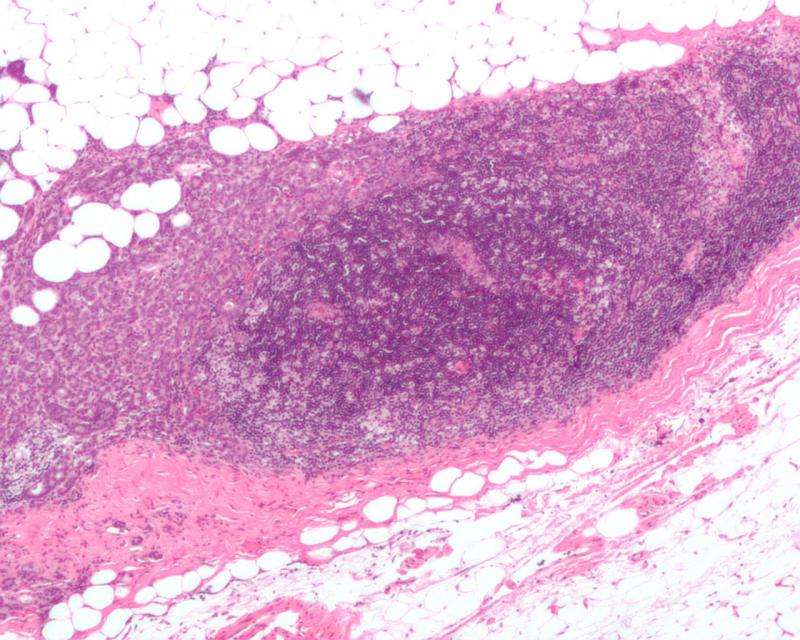Micrograph showing a lymph node invaded by ductal breast carcinoma, with extension of the tumour beyond the lymph node. Credit: Nephron/Wikipedia
A University of Rochester biomedical engineering lab discovered a new way to judge whether breast cancer cells are likely to spread, by viewing tumor biopsies with a powerful multi-photon laser microscope and watching for certain optical patterns emitted by cancer.
New data published by the journal BMC Cancer shows that the optical signals independently predicted metastasis-free survival and overall survival based on 125 tissue samples obtained from patients in the Netherlands. The women, with an average age of 52, each were diagnosed with a common form of early-stage breast cancer: lymph-node-negative, estrogen-sensitive, invasive ductal carcinoma, and were not treated with chemotherapy. Scientists followed their cases for 15 years and correlated the outcomes to the optical signature of each tumor.
Lead author Edward Brown III, Ph.D., built the multi-photon microscope used to analyze the breast tumors. It shines lasers on cancerous tissue and then allows scientists to study how the light scatters as malignant cells move. Because the scattered light patterns can seemingly predict how cancer will behave later on, Brown believes the data could perhaps add new information to what is currently provided to patients at diagnosis.
"Our goal is to aid in treatment decisions by complementing the information that's already available, to help women avoid being over-treated," said Brown, UR associate professor, National Institutes of Health New Innovator awardee, Pew Scholar, and Era of Hope Scholar.
Currently patients and oncologists use detailed pathology reports, genomic tests, and imaging to make decisions about breast cancer prognosis and therapy. However, these tools have varying degrees of accuracy, particularly for predicting the course of early-stage disease. In those cases the tumor is small and cancer is not detected in the surrounding lymph nodes, yet approximately 40 percent of patients in this category fall into a gray area and receive chemotherapy when they might not need it.
Brown's lab has been working for a decade to improve upon diagnostic technology.
His discovery is based on a signal called second harmonic generation, which is produced by the collagen and other fibrous matter that surrounds a tumor, like garden soil around a spring bulb. Scientists track second harmonic generation signals using the high-intensity light of a laser, and in Brown's lab they study how the structure of the fibers impacts the direction of scattered light.
Watching cancer cells travel amid collagen fibers, Brown said, is like observing city dwellers trying to get out of town for the weekend: some fibers around tumors are analogous to smooth roads, others are like roads with potholes and obstacles. The structures may affect the ease with which cancer cells travel, and is visualized with the light scattering technique.
Earlier work by a key investigator in the Brown lab, Kathleen Burke, first demonstrated the association between optical measurements and properties of many types of breast tumors; Ping Tang, B. Med., Ph.D., a surgical pathologist for UR Medicine's Wilmot Cancer Institute with a special interest in breast cancer, and Ryan Dawes, a graduate student in Brown's lab, are also significant contributors to the project.
The next step is to confirm the data in a larger study of breast cancer patients who have been treated with chemotherapy, and to devise a predictive formula or "score" based on the light patterns from their tissue samples. The score could be included in a patient's pathology report, Brown said.
In addition, Brown's lab is studying the optical signals emitted by colon and lung cancer biopsy samples. So far, his technique shows potential to predict the prognosis of stage 1 colon cancer, but not lung cancer.
More information: K. Burke et al. Using second harmonic generation to predict patient outcome in solid tumors, BMC Cancer (2015). DOI: 10.1186/s12885-015-1911-8
Journal information: BMC Cancer
Provided by University of Rochester Medical Center





















